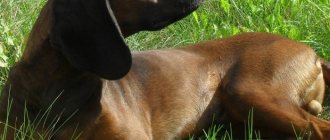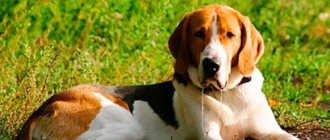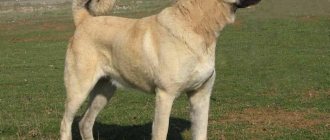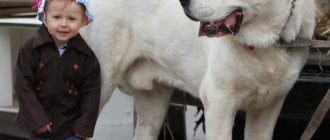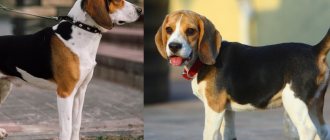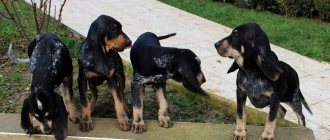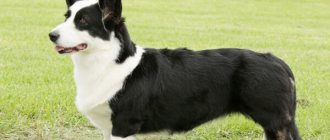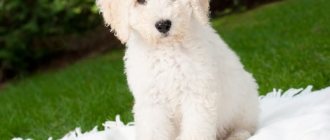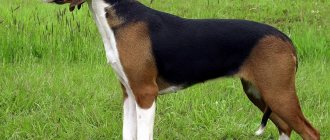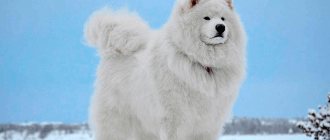The Bavarian Mountain Hound is a medium-sized, short-haired dog. It differs from the Hanoverian hound and bloodhound in its significantly dry build, neatness and is a well-defined border type between the Hubertoids and typical marriages of Czechoslovakia and Austria. Thanks to her excellent sense of smell and hunting passion, she can chase a wounded animal (mostly deer) for many hours in a row.
Bavarian mountain hound
Origin story
The history of the modern Bavarian mountain hound begins in the 70s of the 19th century. Then Baron Karl Bebenburg Reichenhall began breeding a “lightweight” hound for work in mountainous areas. The Hanoverian hound was chosen as the basis; the blood of ordinary hounds, which the Germans called brakki, was added to it. Dogs were selected according to the following criteria:
- Absolute hunting excitement;
- Confident and error-free tracking;
- The joy of hunting;
- Keen sense;
- The ability to follow the trail with your voice.
Secondary importance was attached to external data. The Bavarian mountain hound was registered as a separate breed in 1883. She quickly found her place among hunters in mountainous regions, and then in other areas. In 1912, the Bavarian Mountain Hound Club was founded in Munich to develop and popularize the breed. The FCI recognized the breed in 1996.
Young Hunter School
Activities that allow the development of breed abilities - an active search for something or someone (preferably with overcoming obstacles) - are popular with Bavarians at any age. This can be a search by smell (develops the so-called “superior sense”), tracking (search by trail), searching for an object by its name (memory training) or a familiar person by name. Classes can be supplemented with elements of controlled movement - in the direction of the hand, with verbal commands “left”, “right”, “forward”, “no”, “stop”, “search”. It is very useful to teach you to choose the method you propose to overcome an obstacle: “barrier” or “crawl”. There are situations when a person at height can see a safer path, and in this way one can easily control the dog’s behavior.
Team "Voice!" . Teaching the command is not difficult - the most important thing is to come up with a way to provoke the dog to bark: tease it with something tasty, a favorite toy, etc. (for some dogs, training by imitation is effective - find a friendly, wise dog who has already mastered the desired command, ask him to demonstrate the skills and praise him for the result in front of your dog). As soon as the dog starts barking, quickly consolidate the effect - say the command “Voice!” several times, praise very actively and give this very piece of goodies or toy. The command must be executed from any position (sitting, standing, moving).
Another specific command is “Give it!” . Learn to serve different objects and do it carefully, without clenching your teeth. Useful both for hunting and in everyday life.
Description of the breed
The animal has an elongated rectangular body. The general appearance of the dog - strong muscles, heavy bones, short and strong legs - speaks of the strength of the animal. The head is elongated, the forehead is high. The ears are set high, small, hanging. Eyes brown or black. The jaws are powerful. The tail is saber-shaped, its length just below the hock joint. The Bavarian's coat is short, almost without undercoat, close to the body, and hard. Colors: fawn, brindle, red. White markings on the chest are allowed. Dimensions of the animal: height at the withers of an adult cable reaches 54 cm, females - 50 cm. Weight ranges between 25-27 kg.
Dossier
Height: 48-52 cm. Weight: 25-30 kg. Characteristic color: from red to fawn, the mask and ears are dark, for example brindle color, as well as the presence of white spots on the chest. Coat length: short. Advantages: endurance, balance, complete orientation towards the owner. Difficulties: heavy molting, practically no protective qualities. Life expectancy: up to 12 years. Average price: $250-300. Classification: medium-sized hunting dogs belonging to the group of hounds and related breeds (VI group, section 2). Utility – Bavarian hound following a blood trail.
Purpose of the Bavarian Mountain Hound breed
Purpose of the Bavarian Mountain Hound breed
Bavarian hounds are characterized as hunting tracking dogs. Breeding of the breed began in the seventies of the century before last. Dog handlers purposefully bred dogs capable of hunting badgers and wild boars in the mountains, as well as tracking game using a cold blood trail.
Overexposure
Payment for foster care is discussed with a veterinarian, dog handler, and volunteer. Depending on the purpose of the overexposure, prices will differ. If the dog undergoes a general training course, he remains in the care of dog handlers who observe and care for him. Overexposure costs 20,000.
Training is carried out by dog handlers. The course price includes meals and care. By the end of OKD, the puppy will be able to carry out basic commands, will be socialized and will learn to interact with people. You can invite a dog handler or training specialist to your home. This reduces the amount of costs associated with training by 50-60%.
Based on average prices, you can derive general indicators and create a monthly schedule of expenses for each year. Before buying a dog, you need to calculate the costs associated with it and follow the results. But you also need to take into account unplanned expenses.
Purchasing a dog should be considered and agreed upon with family members. It is advisable for an inexperienced dog owner to enlist the help of an expert or become thoroughly familiar with the standard of the chosen breed. A pet can be purchased through an advertisement website, in a nursery, and also “from hand” in zoological markets, each method has its own characteristics.
Personality of the Bavarian Mountain Hound
Personality of the Bavarian Mountain Hound
The Bavarian Mountain Hound is a special purpose dog. Possessing extreme calm, the Bavarian rarely expresses emotions, but even they are not expressive enough, although they are friendly towards the person. All the strength of temperament is manifested in dogs during the hunt.
The dog is distrustful of strangers, but being a guard or watchman is simply not given to a dog of this breed by nature. With proper upbringing, the Bavarian hound feels respect for its owner, even affection, and always strives to be the center of his attention. It is difficult to get along with other animals under the same roof.
Difficulties arise if there are rodents and other animals in the house that are considered to be hunted by a Bavarian in the wild. Cats, squirrels, rodents are taboo for an establishment if a Bavarian mountain hound lives in the house.
Choosing and purchasing a puppy
In Russia, the breed is represented by only a few dozen dogs. It is better to buy a puppy in the homeland of the hound, choosing one of the German nurseries. A potential dog owner will have to prove that he is a hunter and has all the conditions for keeping and working with a pet. In Russia there are such nurseries specializing in breeding Bavarians: Goddeshunt, Bird's Nest. In our country there is a club for dog lovers - Chronicles of the Bavarian Hound. Owners of Bavarians exchange tips on raising and maintaining pets. Organize joint trainings. The price for a Bavarian hound starts at $2,000. But even despite such a considerable cost, there is always a queue for puppies.
How to choose a puppy
From the litter you should take the most curious and courageous baby, the one who is the first to sniff a stranger. You should also pay attention to the condition of the coat, skin, eyes, ears, and teeth.
The presence of documents and a medical certificate is mandatory.
Nicknames
In the name of a hunting dog, it is customary to emphasize the working qualities of the animal and its character traits. For example: Fast, Thunder, Bass, Alarm, Mischievous, Hurricane, Guy, Roll, Roll, Excitement, Courage, Flurry. The following nicknames are suitable for bitches: Aika, Venus, Volna, Vyuga, Gaida, Zabava, Zvezda, Zapevka, Rocket, Purga, Taiga, Yula, Zven, Passion. Some owners focus on the German origin of the dog, giving the following names: Hans, Elba, Alpa, Gertrude, Gerda, Berg.
The Bavarian mountain dog is a subtle and precise assistant to a person not only in hunting, but also in searching for people missing in the mountains. Only careful treatment of the breed and preservation of its working qualities will help preserve these wonderful animals for descendants.
Nutrition of the Bavarian Mountain Hound
The dog's food at rest and during service differs not only in calorie content, but also in quality composition. When active, your four-legged assistant will require 30% more protein. During the cold season, it is advisable to increase the consumption of animal fats. The smaller amount of fat in the diet is compensated by an increase in the proportion of carbohydrates. They are included in the menu in the form of cereal and vegetable dishes, as well as dried wheat-rye bread. It is soaked in broth, milk or other liquid.
Search on Avito
The popular site is replete with advertisements for the sale of animals and their photographs. Pets are distributed in this way by professional breeders, amateur dog breeders and scammers.
For a reasonable price you can find a worthy purebred representative, or it is also possible to become a victim of fraud. Often, mestizos are sold under the guise of purebred dogs; even a breed connoisseur can find it difficult to identify inconsistencies among small puppies. Of course, a mixed breed can become a faithful companion, but it’s a shame to pay an unreasonable amount; you can get a faithful outbred dog for nothing.
If you buy from an ad, you may encounter a replacement puppy. A photo of a cute purebred baby is displayed on the site, but in fact another one is being sold, and the seller says that “yours” was just bought, and “this one” will soon be taken away too. The buyer, obeying the initial impulse to buy a dog, agrees to what is offered to him. Therefore, before your trip, contact the seller and ask to send a new photo or video; the scammer will probably not fulfill the request and will stop answering calls.
Caring for the Bavarian Hound
Caring for the Bavarian Hound
Like real hunters, they do not need grooming; it is enough to brush their fur regularly. There is not enough data on how much they shed, but we can assume that it is like all dogs.
Their floppy ears require careful care, as they can collect dirt, leading to infections. It is enough to inspect them regularly and carefully clean them.
Activity
This hunter needs space to run. Representatives of the breed are active and require regular exercise. The hound feels most comfortable in the forest and mountains. During a long walk, she literally comes alive. At such moments, you can see your pet in all its glory - playful, with sparkling eyes. This is not only a pleasant pastime, but also a great workout. New smells captivate the dog. Coordination of movements and mental stress become an excellent workout.
But the dog does not forget and runs to check in with the owner. Despite the exciting walk, she rarely runs away from her owner. Therefore, when going with him to the mountains or forest, you should not be afraid that your hunter will run away or get lost. At the same time, they are not annoying at home. The pet senses the owner's mood. If the owner is not in the mood for play, the dog will not attract unnecessary attention and insist.
Bavarian Mountain Hound training
Bavarian Mountain Hound training
Dogs of this breed sense the boundaries of what is permitted very well and periodically test the owner’s strength. In the absence of proper strength of character and consistency in upbringing, at some point you may find that the effectiveness of the efforts made by the Persistent owner is significantly hampered by the actions of the Discouraging owner in his absence. It should also be taken into account that Bavarians are excellent actors and masterfully manipulate people for their own purposes, if the meaning of their actions is not recognized in time and is not stopped.
Appearance
The first thing that attracts a Bavarian in appearance is its unusual color. Red body with smooth transitions and a black velvety mask. This “design” was chosen for a reason. It allows the dog to completely “dissolve” in the autumn landscape, and autumn is the season for hunting ungulates. The Bavarian Mountain Hound is harmonious, agile, flexible, of medium height, slightly elongated, with well-developed muscles. Sexual dimorphism is pronounced.
- The height at the withers of males is 47-52 cm, weight is 20-30 kg.
- Height at the withers of females is 44-48 cm, weight is 17-25 kg.
We recommend reading: Havanese Bichon (Havanese): everything about the dog, photo, description of the breed, character, price
The skull is slightly convex, the brow ridges are well developed. Stop is expressed. The muzzle is slightly shorter than the skull, wide, not pointed. The bridge of the nose is straight or slightly convex. The lobe is large, not very wide, the nostrils are well open, dark red or black in color. The lips are well fitting, of medium thickness, the corners are clearly visible. The jaws are strong, scissor bite, straight bite allowed. The eyes are not too round and not too large, dark brown or somewhat lighter. the eyelids are well pigmented and fit tightly. The ears are hanging, reaching the tip of the nose, heavy, set high, wide at the base, rounded at the tips.
The neck is of medium length. The skin on the throat is somewhat loose. The body is well balanced and muscular. Topline with a slight rise from withers to rump. The back is flexible and strong. The circle is long, slightly inclined (20-30 degrees is considered ideal). The loin is short and wide. The chest is deep and long, moderately wide. The ribs are laid back. The chest reaches the elbow joint. The stomach is slightly tucked. The tail is of medium length, set high, carried horizontally or carried slightly down. The limbs are straight, parallel, well placed under the body, with good angles, pronounced joints and developed muscles. Paws are oval in shape with tightly knit, arched toes. The pads are well pigmented, durable, and rough. claws black or pink.
The skin fits tightly and is durable. The coat is smooth, thick, moderately hard, with a slight shine, and lies tightly. On the head and ears it is thinner and shorter, on the stomach, limbs, and tail it is stiffer and longer. Colors: dark red, fawn, red, russet, brown, and brindle or mixed with black hair. on the back the color of the coat is usually more intense. There should be a dark mask on the face of any color. the tail is often darker. A small white spot on the chest is allowed.
Training the Bavarian Mountain Hound
Training the Bavarian Mountain Hound
The hunting instinct in these animals is developed from birth, so the hunting process itself gives them great pleasure. An inexperienced owner, when training his pet, may encounter stubbornness and obstinacy in representatives of this breed. The Bavarian Mountain Hound is extremely sensitive to correction in training methods, so it is advisable to avoid this by basing training on a reward system. Training must be systematic. They should be carried out by a person who has relevant experience in raising similar breeds.
Nicknames
This breed of dog has many nicknames that have been given to them by their owners throughout the history of their existence. Among males, the most popular of them are: Govor, Spolokh, Kutilo, Pravdilo, Dobyvay, Skakun, Jumper, Crawling, Pickup, Gargle and many others. Bitches also have a large choice in this regard, and it is inferior to males. Among their most popular ones are: Shumka, Bandorka, Klikusha, Pevunya, Rosishka, Vesta, Ryamyanka, Zaklika. The choice is very large, and therefore it is very difficult to decide on a suitable nickname for a pet.
Diseases of the Bavarian Mountain Hound
Diseases of the Bavarian Mountain Hound
Beagle dog breeds have good health and an excellent immune system; they rarely get sick. No hereditary genetic disorders were found in them.
Most health problems in the Bavarian Hound are associated with injuries received while hunting or walking (cuts, bruises, sprains, insect bites, bites from other dogs).
Health
The Russian piebald hound dog is distinguished by good health. Innate immunity makes it resistant to infections. Needs treatment for skin parasites (fleas, ticks), as well as regular deworming.
Diseases
There are no genetic diseases noted. Representatives of the Anglo-Russian Hound breed may have the following diseases:
- Food allergies.
- Conjunctivitis.
- Dysplasia.
- Myositis.
Vaccinations
In order to raise a healthy dog, it is necessary to get vaccinations on time. The preparation stage for immunization includes measures for treatment against fleas and worms. The presence of parasites reduces the effectiveness of vaccinations. You should not skimp on antiparasitic agents: their inaction or weak effect can cause unsuccessful vaccination.
The first vaccination is given to the puppy no earlier than 2 months of age. It has been scientifically proven that carrying out immunization measures at an earlier date not only does not improve immunity, but also significantly increases the risk of disease. List of recommended vaccines: Vanguard, Duramun, Nobivak, Eurikan. On the day the vaccination is scheduled, the puppy is examined by a veterinarian. No deviations in health are acceptable. Temperature and stool should be normal, skin without rashes.
Description of the standard vaccination schedule:
- The first vaccination is carried out at 8-10 weeks, against diseases such as plague, enteritis, parvovirus.
- The second - in a week (booster vaccination). Rabies vaccination added.
- The third - at six months (vaccines against all previously identified viruses).
- The fourth - per year (vaccines against all previously identified viruses).
And then all vaccinations are carried out once a year, for life.
It is important to follow a gentle regimen even after vaccinations. At this point, the immune system is suppressed. It is forbidden to take the puppy outside, introduce changes in diet, or bathe
Physical activity is prohibited
It is forbidden to take the puppy outside, introduce changes in diet, or bathe him. Physical activity is prohibited.
